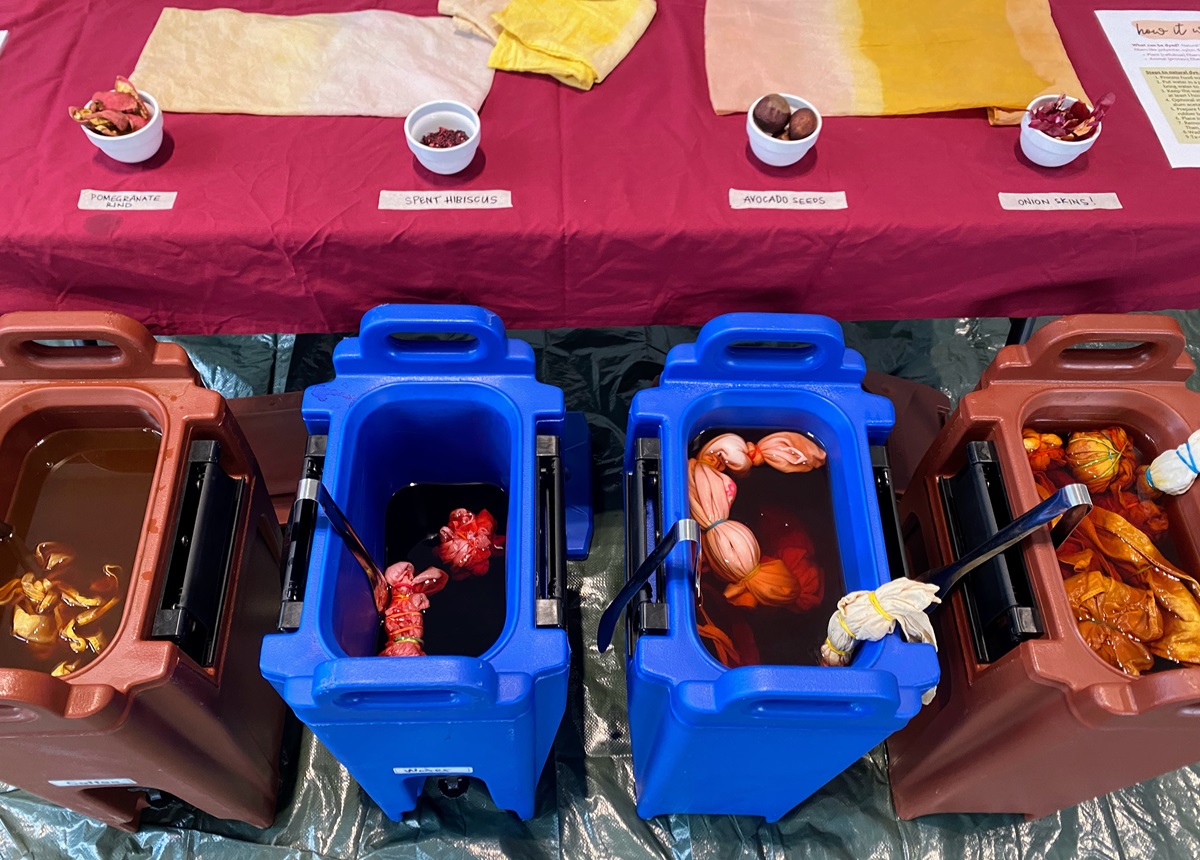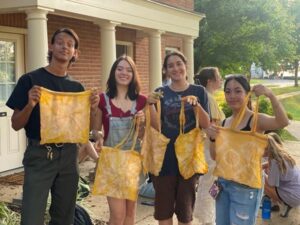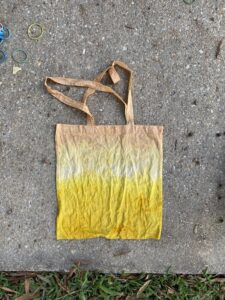A Hands-On Way to Play With Your Food (Waste)
- by bonappetit

Dye pots in action at the PLAN conference
What do avocado skins and seeds, onion skins, and beet trimmings have in common – besides being candidates for the compost pile? It’s a question Fellows Elise Dudley, Elise Kulers, and Hillary Swimmer asked one another when brainstorming ideas for engaging college students during their campus visits. These scraps can all be used in plant-based dyes. This not only reduces food waste, it reminds us of what’s possible when we practice creative reuse and extend sustainable practices from the kitchen out into the other parts of our lives.
This school year, our Fellows have been leading natural dyeing workshops with student sustainability and garden clubs. The workshops are a hands-on way to get students thinking about the many approaches to minimizing waste while drawing parallels between the food industry and the fashion industry – two resource-intensive industries with large carbon footprints.
While tote bags and t-shirts soak in dye pots, the Fellows chat with students about climate and sustainability, and the ways that food waste impacts climate change. The conversations get the students thinking about how they can make an impact on reducing food waste in their daily lives.
This fall at St. Mary’s College of Maryland, roughly 40 students joined Elise D. in a workshop partnered with St. Mary’s College Sustainability Club. They started off by making a big bowl of guacamole, then carefully cleaned the avocado seeds to simmer in a dye pot that would eventually yield a lovely light pink dye. They simmered beet trimmings with onion skins into a reddish orange dye and used turmeric for bright yellow. As fabrics soaked in dyebaths, students discussed the environmental harm of both food waste that ends up in a landfill; and water pollution by synthetic dyes, taking totes bags back with them as reminders of their learning.

Students at St. Mary’s College of Maryland show off their tie-dyed creations.
At St. Edward’s University in Austin, TX, members of the Students for Sustainability club joined Elise K. for a similar workshop to dye cotton fabrics with avocado seeds and turmeric. Students tied up tote bags and old white shirts and upcycled them into vibrant, naturally dyed creations with unique patterns. They were shocked to learn that clothing accounts for 20% of global water waste due to the use of toxic chemicals during the synthetic dying process. These sobering statistics added some additional meaning behind the simple act of dipping old clothes in simmered food scraps.
And students at Whitman College in Walla Walla, WA gathered with Hillary for their version of the workshop and at the end had some awesome yarn, t-shirts, tote bags, and fabric scraps dyed by the onions and avocado waste. (It was especially exciting for the Bon Appétit team to see the final onion-dyed products, due to the famous Walla Walla Sweet Onion!)
We’ve taken the dyeing experience beyond Bon Appetit campuses, too! Most recently, at Post-Landfill Action Network’s (PLAN) Students Towards Zero Waste Conference, Elise D partnered with chefs at Curtis Institute of Music in Philadelphia to recover pomegranate skins, avocado seeds, and onion skins to showcase upcycled common food waste materials. Participants reflected on the importance of creative approaches to understanding and engaging with systemic challenges, and each walked away with vibrantly dyed second-hand shirts, cotton napkins, and tote bags.

The tie-dye workshop has been a draw for students. The workshops have facilitated learning about food waste issues and the broader sustainability efforts underway via Bon Appétit. Moreover, they’ve sparked thinking about the many ways we can creatively integrate sustainable practices into our lives. Again and again, students were surprised to learn about the ways that both industrial textile and food industries impact our ecosystems. And they consistently shared inspiration to expand their thinking about creative uses for waste.
If you’re curious about plant-based dyeing, our Fellows have a few tips for you:
- To achieve a more pink-hued dye with avocado waste, make sure to wash the skins and seeds thoroughly. Any bits of avocado flesh will dull the end result.
- Natural fibers – plant/cellulose fibers (cotton linen, hemp) or animal/protein fibers (silk, wool) – are best for absorbing and holding plant-based dyes.
- Prioritize using second-hand items or old garments that could use a refresh!
- Avoid drying or storing fabric in direct sunlight to prevent fading.
- Use washed fabric, utilize non-reactive vessels like stainless steel or enameled pots, and dampen fabric prior to dyeing.
- For the most colorfast and lightfast dyed colors, consider incorporating mordanting – a process that facilitates bonding the dye to the fiber– to hold the color in the fabric. Read more about mordants and other considerations for natural dye here.
Most of all, enjoy the wonderful excitement of generating beautiful plant-based colors, and take notes as you experiment!
Happy DIY dyeing!